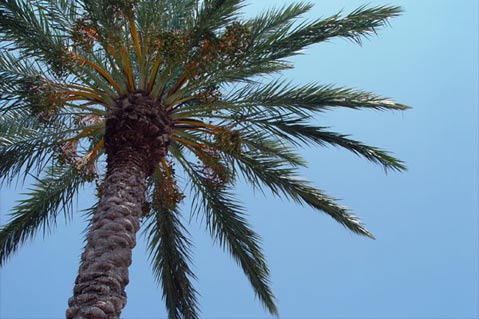Friendly Fronds
Palm Trees are Among the Most Care-Free Plant Selections

Palms have become one of the most beloved and used landscape plants in Southern California. It is no wonder, as there is a palm for almost any situation. From stately Canary Island date palms (Phoenix canariensis) and Chilean wine palms (Jubaea chilensis) to the slender and graceful bamboo palms (Chamaedorea species), they come in all shapes and sizes. They even make good container plants.
In many ways, palms are among the most carefree plant selections. While many palms are from the tropics or subtropics and thus require some water, they can still add a very tropical effect with less irrigation than some other tropical plants. Once established, most will require a good soaking only once a month, but can tolerate more frequent irrigation if surrounding plants require it. Keeping a layer of woody mulch around the plant will encourage good root development and conserve water in general.
Occasional pests include the sucking types such as scale and mealy bugs. Wash these off if possible and strive to improve the overall health of the palm with appropriate fertilizer or increased water.
Stress-free plants are much more readily able to resist predation by insects. Yellowing of parts of the leaves is most likely the result of a nutrient deficiency. If the older leaves show yellowing at the edges, the palm may need more potassium or if the region of the leaves between the veins begins to yellow, it could be a sign of magnesium deficiency. A yearly application of supplemental mineral nutrients will keep the palms healthy and green. If the problem persists, call a professional arborist for proper diagnosis.
There are also a few diseases to watch for. If leaves in the middle of the crown suddenly droop or turn off color, the infection may be fungal and will most likely be fatal. There are several different organisms that attack palms and the most common cause of infection is through pruning tools. It is easy to prevent the spread of this disease by disinfecting tools between trees, however. Soak the saw blade in a 10-percent bleach solution for at least 10 minutes before using on a different palm. It is nearly impossible to disinfect chain saws, so do not use them, and do not allow any arborist service to use their saws on your palms. Another airborn fungus that attacks only the California fan palm (Washingtonia filifera) is known as diamond scale, and there is no treatment available.
Unlike many woody trees that require occasional pruning and training to maintain a healthy canopy, palms require little or no such attention. There are two informal classes of palms, those that are “self-cleaning,” meaning that they drop their old leaves, and those that aren’t. Most of the latter would eventually lose the oldest of the leaves, but some do retain them for their lives. The old fronds form a “skirt” below the living crown. In some cases, this is very decorative and may even benefit the palm by protecting the trunk. In landscapes, it has become the custom to remove those skirts to reveal a smooth trunk. This should be done with care, however. Fronds that are completely brown can be cut near the trunk, but they should never be removed by pulling them away, as this can tear at the outer layers of the trunk. Green fronds should not be removed, as they are still engaged in photosynthesis for the support of the whole tree. It is dismaying, therefore, to see so many palms with skimpy crowns of just a few leaves and unnaturally smooth trunks. This sort of wrongful pruning is not only unnecessary, but can ultimately harm the palm. Many palms even have intricately interwoven leaf bases that can be very decorative if cut carefully.
Most palms are actively growing during the spring and summer months, so that is the time to get them established. Planting in the ground while the soil is relatively warm will ensure that their root systems can grow into their new sites quickly. These months are also the best time to move palms. Among some of the easiest plants to transplant, palms need relatively small root balls. Most palms must regrow a whole new set of roots from near the trunk so the root ball can be designed just to stabilize the palm during that period of regrowth. Large palm nurseries have been established in our area that capitalize on this characteristic and grow their crop in the ground, then dig and wrap them for transport to their new garden homes.
So if you have palms in your landscape, treat them with respect. And if you don’t, why not?



